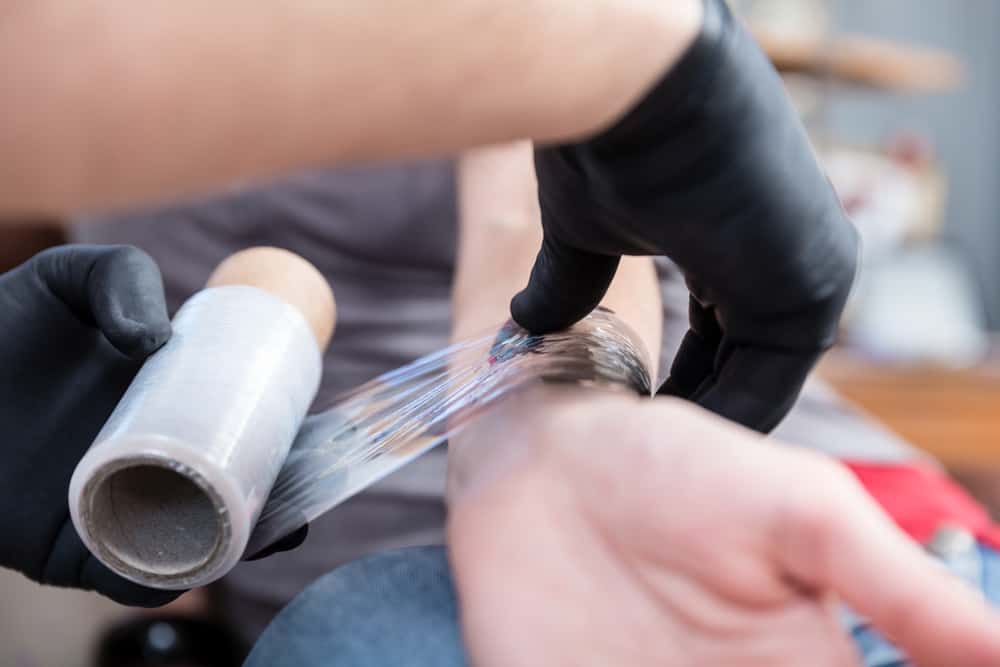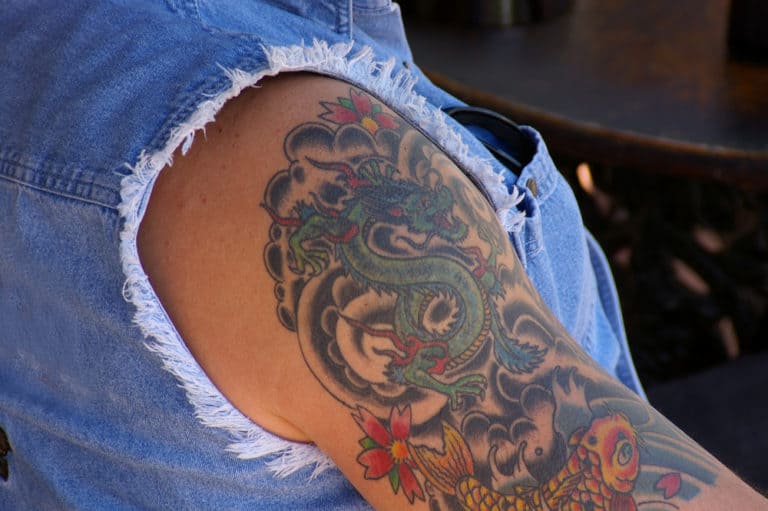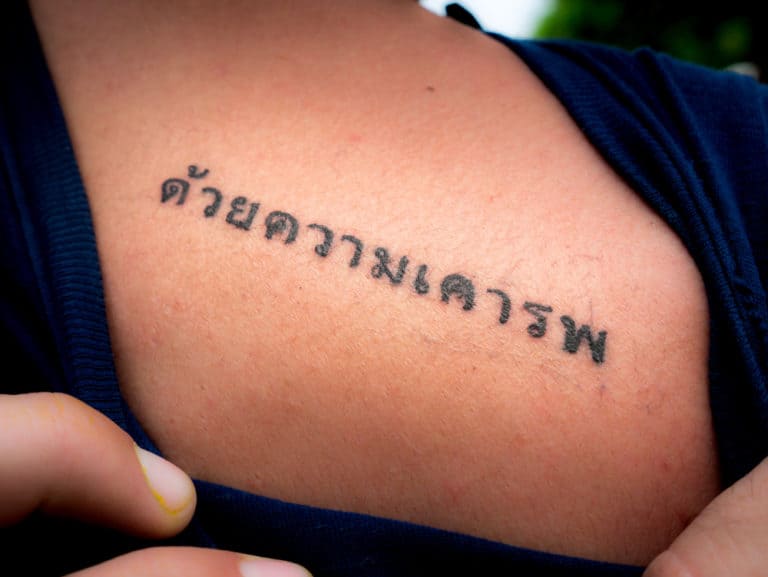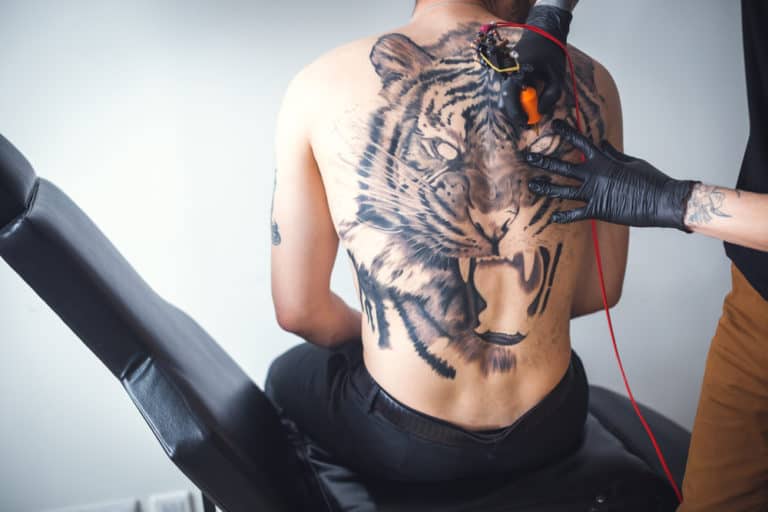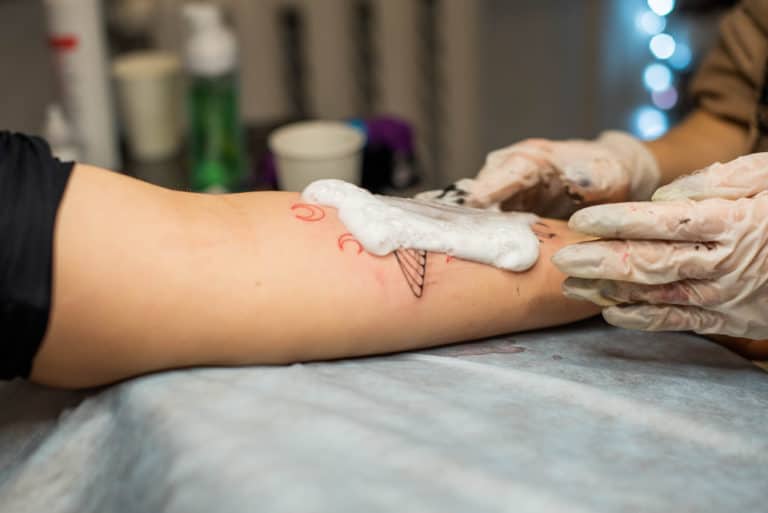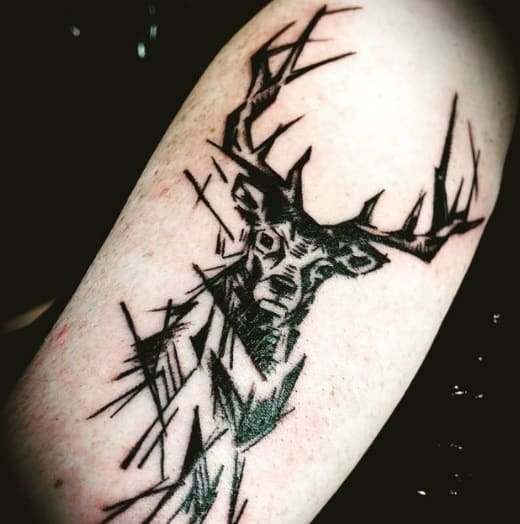How Many Days Should You Keep A Wrap On A Tattoo?
Getting a tattoo is an exciting prospect and often marks an important milestone in the life of the one getting inked. A healing process must follow inking, but how many days should you keep a wrap on a tattoo? I’ll let my tattooed body speak for itself; here’s what you need to know!
A cling film wrap should remain on a tattoo for 3 – 4 hours after receiving it. Remove and replace it with a fresh wrap three times a day and every night before bed. Tattoo film wrap like Saniderm can remain for 24 hours after receiving a tattoo. Afterward, replace it every 2 – 3 days.
You’ll feel better when you understand the tattoo & healing process and know what to expect. Let’s cover different wraps, the differences, and why tattoo artists might tell you to keep your wrap for two days, but ask your friend to remove theirs the same day.
How Many Days Should A Wrap Stay On Your New Ink?
So, you have your mental preparations in order, ready to grit your teeth as you attain your first tattoo? You’re right to consider the aftercare; you want your tattoo to look great so that you can feel good about it. There is a myriad of opinions about how long you should keep a wrap on a fresh tattoo, so let’s look at why opinions vary and what you need to know.
The wrap duration correlates with the type of wrap and the body part that received the tattoo. In other words, not all wraps were created equal. Saniderm wraps, for example, have superb breathability that helps the skin to heal naturally without ointments. However, foil wraps are not as breathable, requiring you to clean and apply ointment to your tattoo several times a day.
These variables are why your best friend and colleague at work will tell you something different. So, who do you trust? You trust your tattoo artist.
Some tattoo artists advise that their customers remove their wraps when they get home, while others recommend an hour, two, four, or even longer. It may help to know that it’s not the wrap that allows the skin to heal; it only protects the skin from bacteria. The skin heals when you allow it to receive oxygen.
Consequently, some people who have tattoos may decide to remove their wrap when they get home and re-apply it before bedtime (we’ll get into why people do this later). They would then remove the wrap the following morning, clean the skin, and re-apply a fresh wrap.
Remember that larger tattoos also take longer to heal than smaller ones, so it’s only natural that they require different care methods. Furthermore, coloring can play an essential role in the healing process; black on your forearm will heal significantly quicker than pastel pink on your armpit.
What Is The Purpose Of The Tattoo Wrap?
The why will often tell you the how, especially with tattoos. The wrap is a temporary barrier against germs and bacteria – biologically speaking, a new tattoo is essentially an open wound that needs considerable care.
The skin must be able to receive oxygen so that it can heal. If the tattoo remains wrapped for too long, the skin will suffocate and become moist. As a result, it will directly impact how the ink heals under the skin, possibly diminishing the quality of your tattoo. Condensation also causes unnecessary bacteria, hindering the healing process, or it can even cause an infection.
Listen To Your Tattoo Artist
Apart from giving tattoos, tattoo artists most likely have a ton of tattoos themselves. They know about the healing process, so listening to your tattoo artist is the wisest option, especially for your first time. While it’s true that not every artist will recommend the same aftercare procedure, they more than likely have a reason why they recommend specific details.
People who have multiple tattoos can reminisce on each one – the history, backstory, reasoning, and of course, the pain. A rib tattoo is considerably more painful than an arm tattoo because those two body areas have different amounts of skin thickness, muscles, nerves, and bones. So, it would also make sense that they need different times to heal, too, right?
A tattoo artist will know these things, meaning you can accept their advice with confidence and assurance.
Should You Change Your Wrap Before Bedtime?
On the day you receive your tattoo, your skin will be more susceptible to friction, bacteria, and infection, and you will most likely experience some bleeding. Thus, tattoo artists suggest going to bed with a clean wrap for the first night and the next two days afterward. It will prevent your tattoo from rubbing against the sheets, plus the sheets will be free from bloody stains.
Unless you have a Saniderm wrap or your tattoo artist states otherwise, you should remove your wrap, clean your tattoo, and apply a fresh wrap before bed. Here’s what you need to do:
- Wash your hands.
- Slowly remove the current wrap.
- Use your hand, applying antibacterial soap and lukewarm water to clean your tattoo.
- Gently pat it dry with an old t-shirt or a paper towel. Avoid bath towels because they are often too abrasive.
- Moisturize the skin with the ointment your artist recommends, or you can use A&D ointment. Get a cream for each tattoo – you don’t want to cross-contaminate any tattoos.
- Re-apply a new wrap to finish up.
Another reason to have a fresh wrap on the first night is the alarming amount of bacteria on our bedsheets and pillows. Our bodies have oils, dirt, and other bacteria that rub off on our sheets and pillows. In fact, did you know that unwashed pillowcases and linens may have up to 39 times the germs of pet food bowls and thousands of times the bacteria of a toilet seat?
Finally, ensure that your bedding is clean before hitting the hay to minimalize the bacteria that can affect your tattoo.
What Does Itchy Tattoo Skin Tell You?
When something itches, our first subconscious reaction is to find relief, often in the form of a traditional scratch. However, in this case, it’s a good thing!
Itchy skin is indicative of a successful healing process. It usually follows dry, peeling, and flaky skin – but don’t be too hasty to apply moisturizing lotion, and don’t try to peel it! Allowing the skin to heal naturally will yield the best results without smothering it with unnecessary solutions.
Furthermore, it’s also normal to see bits of inked skin fall off. It’s not the tattoo coming off; scabs will form because the needle needs to catalyze the skin to start the inking process. With enough time, the skin will heal completely and be free of any previous flakiness or other abnormalities.
Different Tattoo Wraps And What To Expect
There are several tattoo wraps available today, and each one comes with unique properties that alter the aftercare and healing process.
Cling Wraps
If you have a plastic cling wrap around your tattoo, do not keep it on for longer than 3 – 4 hours. Once you remove it, gently clean it and apply the moisturizing formula. Afterward, leave it on for the rest of the day and overnight. Remove it again in the morning and give it another clean and moisturize before applying a fresh cling wrap.
Tattoo Film Wraps
Tattoo film wraps like Saniderm contains modern technology that gives them superior breathability and healing potential. In this case, you would leave the tattoo film on for 24 hours before removing it and starting your aftercare routine.
The aftercare routine includes washing it with antibacterial soap, applying the moisturizer, and drying it. Afterward, re-apply the fresh tattoo film wrap.
Tattoo film is excellent because it allows you more freedom without worrying about making marks on your bedsheets or white clothing. However, this time you want to leave the second layer of tattoo film on for 2 – 3 days instead of 24 hours. Three days later, you can remove the tattoo film entirely and start the healing process.
What’s That Smell?
When you leave it on for multiple days at a time, you can expect to see a buildup of liquids consisting of blood, plasma, and ink – don’t worry, this is entirely normal! If you notice a lot of fluid around the tattoo, consider removing the film wrap and cleaning it. Otherwise, it will break down and cause an unpleasant smell.
The lower parts of the body, such as the legs, will naturally produce more liquid because it gets a lot of movement. Additionally, it’s normal to experience irritated skin near the knee area, and that’s because that area frequently rubs against the wrap.
How Often Should You Wash Your Tattoo?
Tattoos are kinda permanent, so it’s a good idea to keep them looking good so you can keep feeling great. Following a circular motion, ensure that you clean the entire tattoo area, rinse it well and gently dry it. It would be best to wash it three times a day using antibacterial soap.
When completely dry, it’s time to apply the healing ointment. Unless your tattoo artist recommends something else, consider using Aquaphor or A&D ointment. They come with an abundance of vitamins that nourish and protect the skin and speed up the healing process. You can find them among the moisturizers, near the Vaseline aisle with other rash ointments.
Do yourself a favor and avoid regular body lotions because they won’t be as effective as Aquaphor or A&D ointment. Plus, many body lotions contain alcohol that dries the skin and impedes the healing process – even those claiming to “heal dry & damaged skin.”
Aquaphor is a petroleum-based compound akin to Vaseline, but they are also pretty different. It works very well and is not interchangeable with other more affordable products. Even though it’s more expensive than other options, don’t skimp on your tattoo quality and get some Aquaphor.
If you don’t have access to Aquaphor or A&D ointment, your next best bet is to get advice from your tattoo artist. Once your tattoo is far into the healing process, you can switch to something more affordable containing coconut oil and vitamin E.
What’s The General Outline For Tattoo Healing Process?
The skin around more extensive tattoos takes longer to heal because there is more body to heal. Things like picking at scabs, forgetting to moisturize, leaving your skin exposed to UV rays, and using alcohol-based lotions and creams, will all hinder the healing process.
At first, your body will respond easily to injury, and you may notice redness, oozing, slight inflammation or swelling, or a burning sensation. The tattoo artist will wrap your new tattoo; it will be considered an open wound.
Afterward, you will start to develop itchy and flaky areas on your tattooed spots. This is completely natural, and it won’t affect the quality of your tattoo.
Even though the temptation to peel and pick at scabs will be great, avoid it! Applying your prescribed moisturizer will help to relieve the irritation and keep your sanity.
Once the itching stops, you know your skin will start to become drier. If it doesn’t, head back to your tattoo artist to ensure that you do not have an infection.
Furthermore, you will see a layer of dry skin over your tattoo, making it appear dimmer. This aesthetic indicates natural exfoliation that will eventually reveal the vibrant tattoo underneath. So, refrain from picking or scratching since this may result in scars.
Finally, any irritated or itchy skin should now have subsided. The tattoo should look pretty vibrant and brimming with color and health. At this point, it’s up to you to maintain proper aftercare and ensure the tattoo remains hydrated, protected with SPF, and free from UV rays.
Conclusion
Traditional cling wrap is less porous and requires that you remove it 3 – 4 hours after your tattoo. Following that, clean and replace it at least three times a day. Tattoo film wraps like Saniderm breath easily; you can keep it on for 24 hours after your tattoo. After cleaning and replacing it, it will last for 2 – 3 days.
Some of my favorite designs, tattoo books, and aftercare products, selected for you
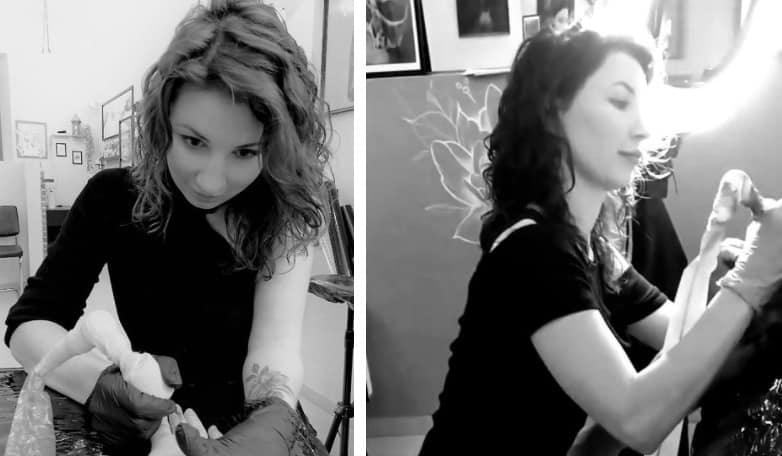
Thank you for reading my article, I hope that you have found it helpful. If you would have trouble finding ideas for your tattoo, wonder what is meaning of design that you have found or what to buy for aftercare, to make sure that your tattoo will be healing quickly and easily, here are some of my favorite products in one place, hope that this will also help.
Design and tattoo ideas
For some ideas you can have a look at those 3 books with hundreds of designs that I use with my clients, they are available on Amazon for Kindle or in classic, paper version (links below):
- Great Book of Tattoo Designs, Revised Edition: More than 500 Body Art Designs (Fox Chapel Publishing) Fantasy, Celtic, Floral, Wildlife, and Symbol Designs for the Skin by Lora Irish
- The Big Book of Small Tattoos – Vol.1: 400 small original tattoos for women and men by Roberto Gemori
- Tiny Tattoos: Over 1,000 Small Inspirational Artworks by Rebecca Vincent.
Tattoo meaning
If you would like to read more about the meaning of different tattoo styles and designs before you will decide what you would like to have, I can recommend a book that was really useful for me when I was starting my tattoo adventure – it’s “Conscious Ink: The Hidden Meaning of Tattoos” by Lisa Barretta (through the link you can find it on Amazon for around $10).
Tattoo aftercare
The skin at the tattoo site often dries out. To prevent it and speed up healing for my clients, I usually recommend one of those tattoo aftercare balms (you can find them on Amazon):
References
- https://www.youtube.com/watch?v=B3zC6DNr0IA&ab_channel=Saniderm
- https://www.quora.com/How-long-to-leave-tattoo-bandage-or-plastic-wrap-on-my-arm
- https://www.quora.com/What-happens-if-you-leave-your-tattoo-wrapped-for-too-long
- https://www.quora.com/How-long-should-a-new-tattoo-be-covered-with-a-bandage
- https://www.quora.com/Is-it-Normal-for-my-tattoo-artist-to-tell-me-to-keep-the-bandage-for-3-days
- https://www.quora.com/How-long-does-it-take-to-keep-a-tattoo-wrapped-in-cling-film
- https://www.businessinsider.com/bed-how-often-should-wash-sheets-dust-mites-fungi-bacteria-2019-5?r=US&IR=T
- https://www.youtube.com/watch?v=Xg9Dv7X6ck0&ab_channel=SorryMomTattoo
- https://www.youtube.com/watch?v=Kunh2VbDzj8&ab_channel=AcidPentagramPizza
- https://www.youtube.com/watch?v=lpPTXZ5aVTU&ab_channel=JustINKD

